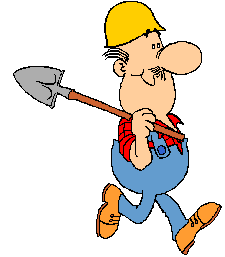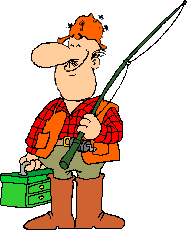

What do YOU do when you get too many fish or they get to be pan
size... I mean too big? No, I don't do this, but I got your attention!!
This page will try to answer that question and others that I get
every day on things that involve non-construction issues about
ponding. Initially, this page will be quite short, but I will
add to it as I get a question that I think others are asking,
I will post the answer here. I will also add a feature here where
you can post questions. Until I can figure out how to do that
though, you can send your questions to me via e-mail at pondguy@pondrushes.net.
Also, if you are one who gets lots of the same questions yourself,
shoot me a note and I will include your answer here.
A lot of these answers are posted regularly on rec.ponds,
but those answers don't stay around and are not indexed. I hope
this medium will serve you better.
Index
1. What do you do with too many fish or when your fish get too big?
2. How do I divide my hardy lilies?
3. How do I divide my tropical lilies?
4. To pump or not to pump that is the question... Or is it filters? Or balance?
5. Some ponderings on the hobbie of ponding...
6. Chemicals???
7. Pond Piping Calculations from R. Totman
8. Winterizing your pond?
9. Building REALLY big and/or earthen ponds...
1. What do you do with too many fish or when your fish get too big?
There are several solutions to this problem. Many pet stores
will buy your excess fish or trade them for store credit. I kept
myself in Tetra food for a couple of years this way. The same
goes for some pond stores. Call around and see what kind of deals
you can work out.
The trick is catching them. Short of draining your pond, this
may not be easy. For small ponds, netting may work. For larger
ponds, I have seen some people use large seine nets that are laid
on the bottom of the pond for a few days to get the fish used
to it and then when the fish are eating, pulled quickly to the
top.
You can also get a friend or 2 and have a fish roundup and
shoo them into a fish corral. Naturally, we are better at fish
wrangling here in Texas and few points west, but some of you Yankees
might get the hang of it...
2. How do I divide my hardy lilies?
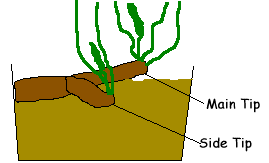
Hardy lilies are easy to divide. A hardy lily grows from one
end of a tuber, like a carrot lying on its' side. It may also
develop little, or not so little if you haven't repotted in a
while, side tubers. You can break off each side tip and pot them
separately. You also need to shorten the main growing tip. I like
to use pieces about 3 inches long. I have seen shorter pieces
grow, but they are REAL puny the first year.
Since the tuber grows from the tip, the way you put it in the
pot makes a difference. Put a few plant tabs in the bottom of
the pot and cover with dirt to within a couple of inches of the
top. Put the tuber in a trench in the soil and put the non-growing
end against the pot side and the growing tip towards the center.
Tamp dirt around it and cover it with large rocks.
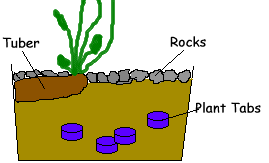
In selecting pots, wide and shallow is the way to go. I like
pots about 6 inches deep and 18 inches in diameter. These are
light enough to get back out of the pond but big enough to go
a few years between repottings.
When selecting dirt, DO NOT USE POTTING SOIL!!! IT FLOATS!!!
3. How do I divide my tropical lilies?
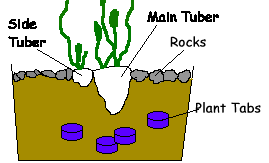
Tropical lilies have a different shape tuber, it is commonly
called a 'nut'. There are two different ways these guys multiply.
The most common will see new nuts developing on the side of the
main nut. You can repot these by breaking off the small nuts and
potting them up separately.
The other type will have new nuts developing right on the lily
pads floating on the surface. These can be broken off and potted
as well. This type of tropical, a viviparous, can be sort of "prolific".
I have seen the nuts on the leaves growing more leaves and blooming
as well!
A tropical is potted as a hardy except that it is potted in
the center of the pot.
4. To pump or not to pump that is the question...
Or is it filters? Or balance?
There are lots of questions about pumps, filtration, pond balance
and so forth. No matter what kind of filtering/pump you choose,
you still need to achieve a good pond balance. Actually, balance
is kind of a misnomer. The reality is that the more plants you
have, the better - in providing cover for the fish, and removing
the junk in the pond that causes algae blooms.
The 'no pump' schools of thought are trying to achieve a Mother
Nature balance. In natural lakes, Mother Nature provides pumping
with incoming and outgoing streams and thru the dirt bottom and
other natural forces to circulate and exchange water. Filtration
is achieved with gravel bottoms and plants. Also, the ratio of
fish to water volume is extremly low.
However, most natural lakes are not as clear as the average
ponder wishes so that they may enjoy the fruits of their labor.
We don't usually have streams flowing into our ponds. We usually
use liners to contain our ponds. We also like to use a much higher
fish to water ratio. Already we have created an un-natural environment.
Lakes also circulate their water by periodically 'turning over'.
This is when the gasses in the decaying junk in the bottom of
the pond get so great that they all start rising at the same time.
They don't usually make it to the surface, but they do stir the
water and all the junk in the bottom, which a ponder does not
want.
So how does one provide a 'natural balance' we have to duplicate
or replace those things that Mother Nature normally provides.
We incorporate pumps to circulate the water. Water circulation
is VERY IMPORTANT. In lakes, fisher persons will tell you that
there are areas that you will never find fish. Why? The water
does not circulate and will build up pockets of dead water where
there is no oxygen and lots of toxic gasses. We don't want those
pockets in our ponds so we circulate. Once we start pumping, we
start running into a problem. There is all kinds of junk floating
in ANY body of water. Unfortunately, that junk will clog your
pump, so we have 2 options, either keep the junk from getting
to the pump, mechanical filtration, or get a pump with big enough
holes that just suck the junk on thru. (I have a pump that will
suck up 1/2 inch ball bearings!)
In a nutshell, that covers pumping and mechanical filtration.
There is more to it than that, but those are the main points.
Now for biological filtration. I already noted some of the differences
our ponds have versus Mother Nature. Two of them, no gravel, and
fish volume are an equation that add up to mean biofiltration.
Let's take the points one at a time. Mother Nature provides biological
filtration in all her healthy water systems. There are things
in all of them that provide a place for micro organisms to grow
that will convert the toxic gasses in the water that are generated
by the fish and thru plant decay into useful things for the plants.
Natural processes produce ammonia and nitrites which will kill
your fish and eventually your plants, into nitrates which is basically
fertilizer which the plants use. The micro organisms grow on EVERYTHING
in a body of water and the more surface area, the more organisms.
Hence the value of gravel beds - lots of surface area for micro
organisms.
Fish volume is the next problem. The rule of thumb in water
gardening is about 2 inches of fish for every square foot of water
surface area. I always thought this a strange rule. I guess it
is OK if your fish live on the surface of the water, but frankly
when mine start living there, I scoop them out and bury them in
the garden because they've gone 'fins up' and aren't living. The
rule of thumb REALLY works out in your average pond to is 2 inches
of fish for every 12 to 15 GALLONS of water - assuming an average
of 1 1/2 to 2 feet of depth. And that is still higher than most
lakes you will run across mainly because they are MUCH deeper.
The ratio there is probably 2 inches for every 120 to 150 gallons!!!
So we have introduced more fish than you see in nature, and
we have less stuff in our ponds to grow the micro organisms to
take care of them. We either have to keep fewer fish, or create
an environment for more micro organisms to take care of the extra
load. And that is the main purpose of a biological filter. It
is a container that contains some sort of material that is high
in surface area to grow micro organisms to convert the toxic junk
in the pond water we pump thru. As an added bonus, most biofilters
also help to get the junk off the bottom of your pond. It ends
up in your filter, but you can clean that easier than you can
clean you pond.
If you really want more information, you need to look at my
Building... page where I do
another 'rant and rave'.
5. Some ponderings on the hobby of ponding...
A few Thoughts from Tim Wardell on ponding After months of
planning ... two weeks ago I dug the hole and installed the liner.
Last week I got the waterfall and pump working. This week the
fish and plants went in. I've now completed my first pond. (Please,
hold your applause.) So, FWIW, here is my list of observations
as a first timer. (These are in no particular order, BTW.)
1) Plan, plan, plan. Read anything and everything you can
to learn about this wonderful hobby. Attend local pond-club meetings.
Go on pond tours. Plan exactly what you want to do and ASK QUESTIONS!
I've met people who "just started digging one day."
They've got some scary stories to tell.
2) It will cost more than you think so plan for overruns.
3) It will take longer than you think. Mother Nature may not cooperate
with your schedule.
4) Rock is expensive. If you can find your own, do it.
5) You can build your own biological filter for a fraction of
the price of buying one. Build your own and save $$.
6) You don't have to buy plants and fish. If there are other water
gardeners in your area, they WILL have extras.
7) Make it as big as you can. This is addictive! Your pond may
seem huge when it's just a hole in the ground, but it seems smaller
once the liner, rock, fish and plants are in.
8) Halfway through construction - when you have a huge hole in
your yard and rock is stacked everywhere - you'll think you've
made a huge mistake. "What am I doing?!" Take a few
deep breaths. Remember your vision and push ahead. In 3 weeks you
will be very pleased with yourself.
9) If you're considering building a pond, do it! Nothing soothes
the soul like the sound of running water and the sight of colorful
fish and flowers.
10) Have fun. This isn't rocket science. Be creative and enjoy it!
Good remarks, thanks Tim...
6. Chemicals?
I have a philosophy I would like to share with you. Quoting from the
Gospel of Chuck, Chapter 2 verse 1, "Put not those things into the pond
that you cannot easily remove, lest it be of need most dire. For verily
I say unto you those things will gather together in abundance and there
will be great gnashing of teeth." If you can't take a chemical out or it
won't evaporate, it will build up to the point that you have to start
doing water changes. There are many people who change as much as 1/2 of
their pond water every month!! Think about it, you have a nice stable
environment that your fish are really doing well in and all of a sudden,
you rip out half of their environment and replace it with new, dead stuff.
This HAS to cause stress to them and a stressed fish is more prone to
disease. Not good. Another reason not to put stuff in it is we are not
really sure of the "side effects". For instance, the chloramine "remover".
How can it "remove" the chloramines? No one has been able to tell me,
but what I think the stuff does is to break the chlorine/ammonia bond so
that the chlorine will evaporate and your biofilter can convert the
ammonia. But what does it convert ammonia to? Well, we heard last week
that a biofilter converts nitrites to nitrates. Ammonia is a nitrite and
ammonium nitrate is a fertilizer. Too much fertilizer, or nutrients in
your pond water mean a likely algae bloom. In a nutshell, when you add
chloramine remover, you are feeding the algae. Thus endeth the lesson...
If you want more info on that, check out the Tips... page.
Other chemicals, such as fish drugs may be necessary to be added but it is
better to separate the sick fish into a holding pond and treat that rather
than treat the whole pond. Other than that, if I add anything to the pond,
it will be organic that will either decompose, evaporate, or be large
enough that I can scoop out.
7. Pond Piping Calculations from R. Totman
rtotman@oanet.com
For those of you who saw this posting two weeks ago, my apologies,
but several people have taken the trouble to thank me by e-mail.
I have changed it slightly to make it simpler to understand:
Many people have asked about the pressure drop in pipes at
various flows. The table at the end gives some idea of the losses
along a straight pipe of the internal diameter shown. Always measure
the actual inside diameter and use the column for the nearest
size. The NOMinal pipe size is only a rough guide. Different pipe
schedules have different bores for the same nominal size.
The table gives the pressure loss in inches of water for a
length of 10 feet of straight pipe at a variety of flows in US
gallons per hour. (English or Imperial gals are 1.2 times larger
so 12 US gals equal 10 Imp. gals.) The table is given in inches
of water to avoid the very small fractions that would occur if
feet were used.
It doesn't matter whether the pipe is horizontal, vertical
or inclined, the loss, measured from some reference level, like
the surface of your pond, will be the same.
Your piping may have some 90 and 45 degree elbows, tees, valves,
etc in it. To get the total EQUIVALENT length of pipe from, say,
your pump discharge nozzle to the top of your waterfall, add all
the straight lengths of pipe together, measured in feet from the
middle of each bend, and then add the following for each fitting:
90 DEG ELBOW: add 32 times the pipe bore converted to FEET.(ie
divide the product in inches by 12) For example, a 3 inch elbow
has the same resistance as 8 feet of straight pipe. (32 x 3" / 12 = 8 ft)
45 DEG ELBOW: add 15 times the pipe bore and convert to feet.
WEDGE GATE VALVE: add 8 times the pipe bore and convert to
feet.
TEE WITH FLOW STRAIGHT THROUGH: add 18 times the pipe bore
& convert to ft.
TEE FLOWING ROUND BEND: treat as 90 deg elbow, or as 2x90s
if flow splits 2 ways.
GLOBE VALVE WIDE OPEN: add 325 times the pipe bore and convert
to feet.
In other words avoid globe valves like the plague except for
side streams or drains where pressure loss is not a factor. Globe
valves are those like a domestic tap that you cannot see through
when you look into the valve body. The flow goes through the valve
in an S pattern. Wedge gate valves, on the other hand, provide
a clear, round hole when you look through them.
If your system has different bore pipes in it, treat each section
separately, then add all the separate loses together. Pump suction
piping is often larger bore than the discharge piping. If your
total equivalent pipe length comes to, say, 35 feet, multiply
the pressure loss from the table by 35/10 or 3.5 to get the total
loss, since the table is for 10 feet of equivalent pipe length.
To determine pump head required, add all the losses calculated
as above to the difference between the pond level and the highest
level at which the water leaves. For example, if the top of your
waterfall is five feet above the pond level from which the pump
takes suction, add this five feet to all the pipe losses to get
the total pump head required. It doesn't matter whether the pump
is submerged or outside the pond, the important levels are the
pond surface and the highest discharge point.
If you have a fountain and you want a jet 5 feet high above
the nozzle, you will need a pressure of 7 or 8 feet of water at
the nozzle. If that nozzle is much above the pond surface, add
that difference on as well. If the fountain requires, say, 10
feet of water above the pond surface, but the waterfall is only
4 feet above the surface, you will need to throttle the waterfall
flow to get enough pressure at the fountain. The fountain then
determines the pump pressure required, ie 10 ft head.
Now the table:
| Pipe size, NOM | 3/4" | 1" | 1-1/4" | 1-1/2" | 2"> | 2-1/2" | 3" | 4" | 6" | |
|---|---|---|---|---|---|---|---|---|---|---|
| Actual bore | 0.824 | 1.049 | 1.38 | 1.61 | 2.067 | 2.469 | 3.068 | 4.026 | 6.065 | |
| USGPH | USGPM | ----- | ----- | ----- | ----- | ----- | ----- | ----- | ----- | ----- |
| 60 | 1 | 0.4 | 0.1 | |||||||
| 120 | 2 | 1.5 | 0.5 | 0.1 | ||||||
| 300 | 5 | 7.6 | 2.3 | 0.6 | 0.3 | |||||
| 480 | 8 | 18 | 5.5 | 1.4 | 0.7 | 0.2 | ||||
| 600 | 10 | 28 | 8.3 | 2.2 | 1.0 | 0.3 | 0.1 | |||
| 900 | 15 | 18 | 4.5 | 2.1 | 0.6 | 0.3 | ||||
| 1200 | 20 | 7.7 | 3.6 | 1.0 | 0.44 | 0.16 | ||||
| 1500 | 25 | 12 | 5.3 | 1.6 | 0.65 | 0.23 | ||||
| 1800 | 30 | 7.5 | 2.2 | 0.9 | 0.3 | |||||
| 2100 | 35 | 10.1 | 2.9 | 1.2 | 0.4 | 0.11 | ||||
| 2400 | 40 | 3.7 | 1.5 | 0.5 | 0.14 | |||||
| 3000 | 50 | 5.6 | 2.3 | 0.8 | 0.21 | |||||
| 4200 | 70 | 11 | 4.4 | 1.5 | 0.4 | |||||
| 5400 | 90 | 7.0 | 2.4 | 0.62 | ||||||
| 9000 | 150 | 19 | 6.2 | 1.6 | 0.2 | |||||
| 10500 | 175 | 8.3 | 2.1 | 0.3 | ||||||
| 12000 | 200 | 11 | 2.7 | 0.4 | ||||||
| 18000 | 300 | 23 | 6 | 0.8 | ||||||
| 24000 | 400 | 10 | 1.3 | |||||||
| 30000 | 500 | 2.0 | ||||||||
Note that, in practice, the equivalent length of pipe will
be approximately twice the actual length of straight pipe in a
typical pond piping system. For example, suppose the piping from
a submerged pump (no suction piping to consider) has 25 feet of
2 inch pipe plus 3 x 90 deg bends, 2 x 45 deg bends, one tee
flowing straight through, and one gate valve. The total equivalent
pipe length will be:
| 2 inch pipe | 25 feet |
| 3 x 90 deg bends | 16 feet total |
| 2 x 45 deg bends | 5 feet total |
| 1 x tee through | 3 feet |
| 1 gate valve | 1.3 ft |
| Total equiv length | 50.3 feet |
As for your fish. The rule is that you should stop feeding
them when the water temperature gets below 55 degrees. Koi and
goldfish have very primitave digestive systems, basically no stomach,
and cannot digest heavy foods in cold water so they just block
up and die. Where I am, N. Texas on the cusp of regions 7/8, the
water jumps all around this temp. I DO feed them in the winter
when the water temp rises, but only when there is no cold snap
predicted for at least a week. Then, I only feed them grains and
vegetables. Cheerios are great as they are mostly oats. Your fish
will also go nuts over thawed frozen peas (they float, canned
ones sink).
Where you are from and that will make a difference on what
you need to do with your plants, filter, etc. Here it is usually
alright to leave your pump running all the time just to keep the
thing from freezing if for nothing else. If you do this, raise
your pump nearer to the surface. My pump sits about 8 inches below
the surface on a plastic milk crate in the winter. What this
does is circulate only the colder surface water and leaves the
warmer deeper water alone.
Since we only get a couple of inches of ice here that lasts
for at most 2 weeks at a time, all our plants usually do just
fine by dropping the plants to the bottom of the ponds to sit
for the winter. This is also a good excuse for making deeper ponds.
Leave the 18 inch and shallower ponds for bogs only.
9. Building REALLY big and/or earthen ponds...
If you're planning a really BIG pond, or are going the natural/earthen pond route,
I'm probably not the expert there, but fortunatly others are. Check out "Earth Ponds",
$19, "The Earth Ponds Resource Book", $18, and "Earth Ponds Video", $33, all
by Tim Matson. You can get them at:
Earth Ponds Company
RR1, Box 17
Thetford Center, VT 05075
There are also some great books available from out friends in the
government! Check out your local state Department of Conservation for
literature. They might even be able to help you with stocking. You can also
get some good stuff from the US Natural Resources Conservation Service.
They're part of the US Dept of Agriculture. Call and ask for their pond
books, especially "Ponds - Planning, Design, Construction". And lastly,
write the Missouri Department of Conservation - Fisheries Editor, Box 180,
Jefferson City, MO 65102-0180. Ask for their "Missouri Pond Handbook".
Best of all, both the Missouri and the NRCS books are free!!! There's also a
great magazine oriented to ponds like this called Pond Boss. You can get to
them at http://www.pondboss.com.
Now, just because you're planning a big pond, doesn't necessarily mean that
you have to go a dirt bottom pond. Off the shelf, you can get rubber liner
up to 100x100 feet. For even larger ponds, you can get a liner material
called Permalon in sizes up to about 275x275 feet. You can also order both
of these materials in custom sizes where the seams have been done at the
factory. Any seams you do on the liner at the bottom of your pond
WILL leak. Also, I don't have any personal experience with Permalon, but it
has been used by municipalities for water treatment plants for years. You can
do a quick search on Yahoo for Permalon for dealers or go to the manufacturer
at http://www.geocheminc.com/products.htm.
I will add other stuff as I can think of it....
Don't forget, if you have any more links or have any questions,
shoot me an email at
pondguy@pondrushes.net
 Back to the Start?
Back to the Start?
